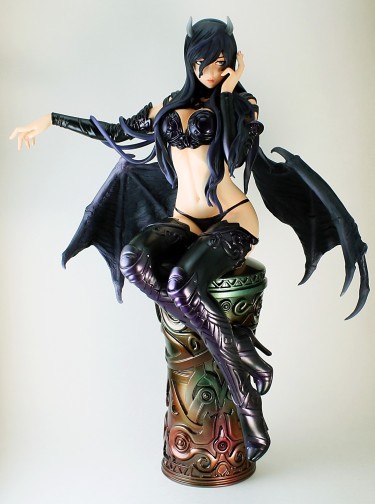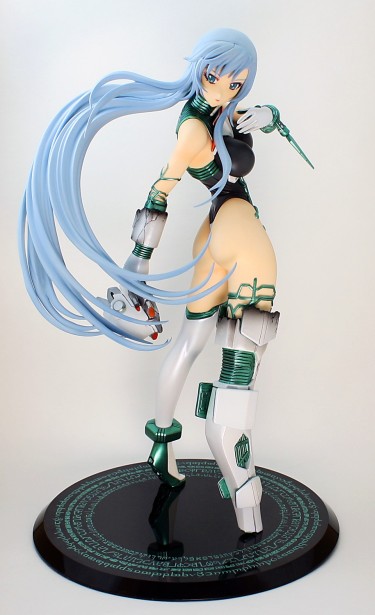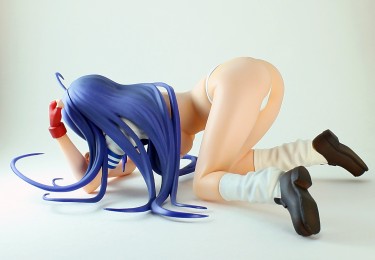I’ve only been taking pictures for a few months, so I’m not all that expert at photography. My photoshoots are mostly trial and error (a lot of trials and almost as many errors) as I shoot off a few pictures, change a setting, shoot more pictures, and then transfer them to my computer to examine what’s different.
I’ve wanted to experiment with a light-colored background as an alternative to the black cloth that I use for most of my pictures. I tried using a sheet of white muslin as a backdrop in some of my earlier pictures, but the results were so poor that I’ve stuck with the black background. Years ago, I read an article detailing how to build a lightbox, and I tried it out then and it didn’t work too well for at least a couple of reasons: one, I only had one lamp, and two, I had no idea what white balance and exposure were.
Meronpan wrote of his struggles with getting a pleasing white background, and that reminded me of the lightbox I had improvised for my Kaguya Nanbu pictures. I wasn’t sure if I liked the lightbox photos, but I only had 60 watt bulbs available, and I wondered if more robust lighting might improve my pictures.
I had to go take my car for an inspection today and as providence would have it the gas station I went to was next to a Lowe’s, so I picked up some new light bulbs. Equipped with 100W bulbs, I took some more pictures of the two figures I most recently reviewed and subjected them to an unhealthy amount of Photoshop.
I like how the details of the figure are easier to see on the white background than the black cloth, but I’m equivocal as to how the white background actually appears. It looks remarkably like a sheet of off-white posterboard, which is of course what it actually is. I wonder where I can find a large sheet of sturdy, high-gloss white paper.
I used the box to take a bunch of pictures of Griffon’s Kanu Uncho, which will be my next figure review. Here she is in a pose of regal dignity and comportment. Classy indeed.














Nice effect!
hmmm i wonder if it’s the posterboard color or still just not enough light making it to the bg? ‘course with 100W bulbs you’d think you’d have enough… mebbe try 150W? ^^; though if they’re incandescent it’s gonna start getting a little toasty in there ^^;
Yeah, I dunno … maybe I might see if I can find some kind of gloss coat spray and spray down the posterboard to improve its reflectivity. Or I might just buy another lamp; the brute-force approach is usually my first and favorite choice when it comes to solving a problem. I do like how a white background looks in general, so I’m going to keep fiddling with my setup and hope that I come across something that works well.
I know I’m commenting on an older post here, but I just recently found your website.
For shooting hot white, the best thing is to use a roll of white seamless paper. Seamless paper can be ordered in varying sizes and colours from any reputable photography store. (I usually get mine from B&H Photo.) And the rolls aren’t terribly expensive, either.
As an example, I used a roll of white seamless for this shot of Kanu: http://www.flickr.com/photos/cwichura/3087589341/ and you can see the setup for the shot here: http://www.flickr.com/photos/13389582@N03/3087607729/
If you look, earlier figurine shots I experimented with using a real lightbox, and the background did not come out anywhere near as well. So I went abandoned the lightbox and went back to seamless like I would use when photographing a real live person.
Granted, I am using studio lighting equipment here, but even with your DIY continuous lighting, you should be able to achieve good results. The photo of Kanu has had no photoshop work done on it at all. The main thing when shooting for a hot white background is the spatial separation of the foreground and the background as you need a lot more light on the background and you don’t want the spill/kickback from that to wrap around the figure too much. (If you do, it will give you more blurred edges around the figure, for a bit of a halo/soft focus look.) The background should be metered to a couple stops higher than the foreground.
Thank you for the comment! I’m hoping to get pictures that turn out similarly to your Kanu Uncho photo (without much success). I haven’t used white backgrounds much after my initial experimentation with a lightbox because I wasn’t all that satisfied with the results, but your method looks much more appealing and straightforward than a cloth-wrapped cardboard box. I’ll definitely try it out.